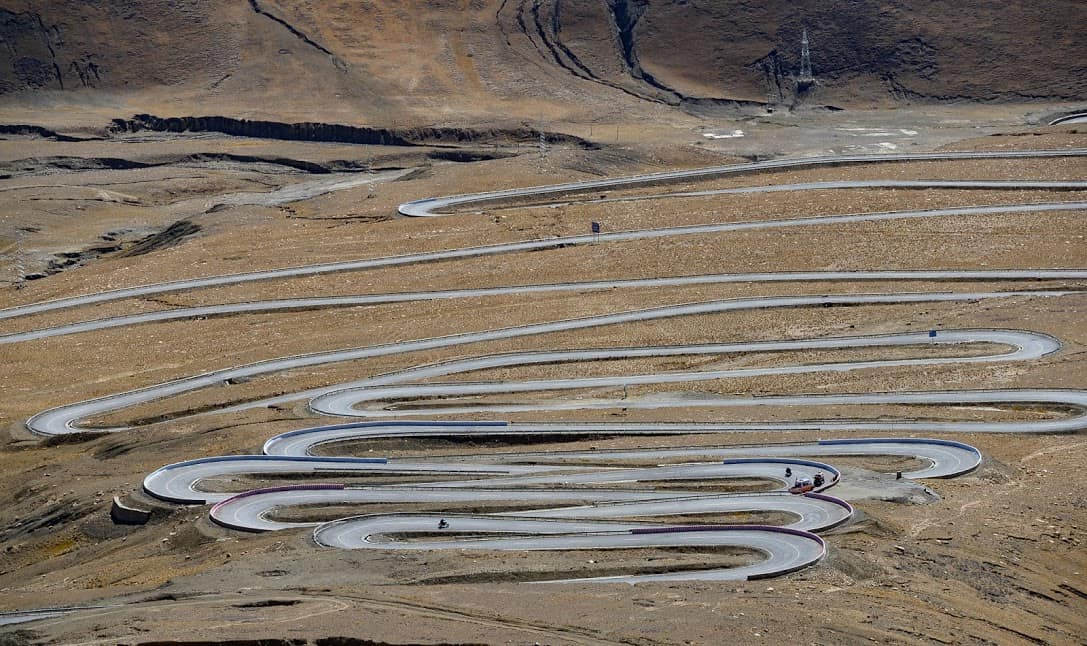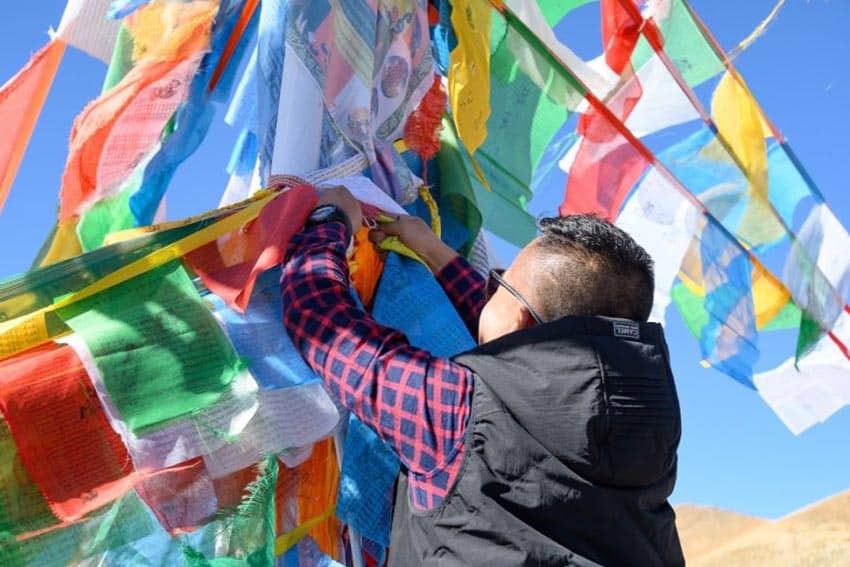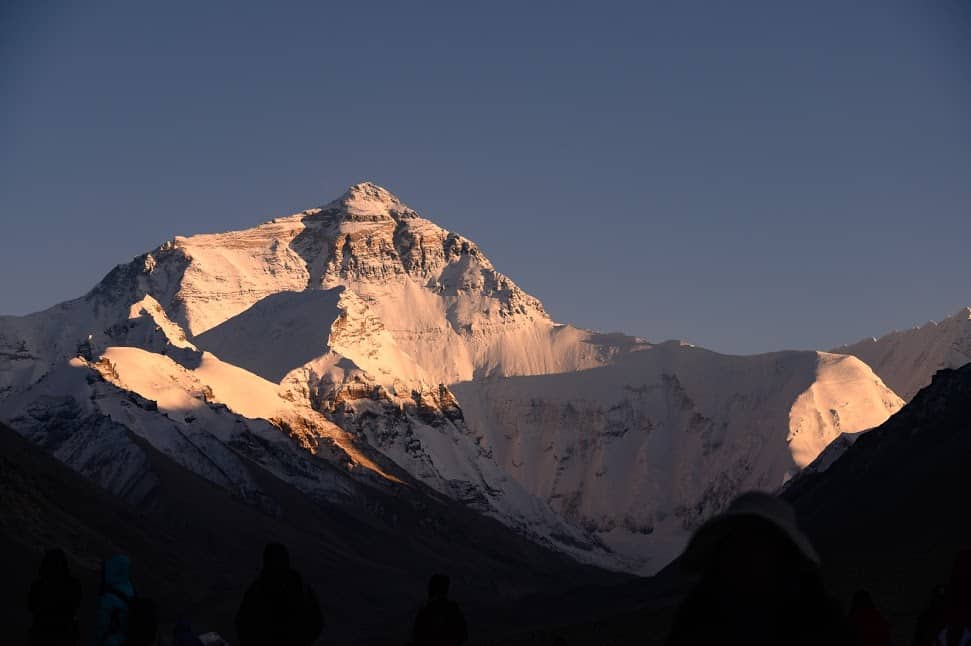
Rockin’ and Rollin’ The Friendship Highway Across the Roof of the World
By Donnie Sexton
When I told family and friends I was going to the base camp of Mt. Everest, they gave me a look of pure shock and disbelief. They knew I’m wasn’t some Herculean creature with the endurance to hike two weeks with a heavy backpack to the base camp on the Nepal side.
The Tibetan or north side of Mt. Everest was a different story. It’s possible to drive to the base camp, commonly referred to as EBC (Everest Base Camp). Their doubt quickly turned into curiosity as to how such a trip would unfold.

Tibet, now an autonomous region of China, is frequently referred to as the “Roof of the World.”
I had made this same trip 20 years ago, traveling from Lhasa, Tibet to Kathmandu, Nepal overland. I felt compelled to repeat the journey, curious as to what changes I might see.
China and Tibet Visas Needed
Back then, it only took a passport to enter China and Tibet. Today, to enter Tibet, you need both a China visa (which you can apply for on your own) and a Tibet visa.
You cannot wing it on your own in Tibet. You must use a private guide or travel with a tour company, and they will assist in getting the Tibet visa for you.
My adventure started by flying to Beijing and spending the night. VistaTibet, the company I traveled with, had my Tibet visa waiting for me at the hotel. The following morning, I flew to Lhasa. Everything I read stressed the importance of acclimating to the altitude before reaching EBC.
I gave myself three days in Lhasa, one of the highest cities in the world at 11,995 ft., to make the adjustment. The altitude definitely made its presence known, as I had to slow down my pace significantly so I could catch my breath.
Devout Worshippers

It was in Lhasa that I was awestruck by the devoutness of the Buddhist worshipers. Day and night, hundreds of pilgrims prostrated themselves in front of the holy Jokhang Temple in Barkor Square, the centerpiece of Lhasa.
Prostrating involves going from standing with arms raised in prayer, to kneeling then stretching out flat on the ground repeatedly.
Many of these devotees were easily in their 70s and older. Others were fingering prayer beads or spinning small prayer wheels, all the while chanting under their breath.

My local Tibetan guide Tensin said these Buddhist disciples weren’t praying for themselves, instead, they were praying for all of humanity.
Their sincerity read like an open book on their faces. I left Lhasa with a deep respect for these devout souls, knowing some of their prayers touched me.
Friendship Highway
On day 4, our group of 10 travelers (eight women, two men) boarded the bus for the long drive towards EBC via the Friendship Highway.
Twenty years back, the highway was nothing but a gravel and dirt road.
Now, completely paved, it was in excellent condition. Tensin started the overland journey by gifting each of us with a can of oxygen (or maybe that was an omen).
The going was slow. The bus snaked up and down the mountains, crossing two passes, Kamba La (15,420 feet) and Karo La (16,522 feet). These crossings were marked by thousands of colorful prayer flags fluttering in the wind. In the distance were our first views of the snow-covered Himalayas.
We made a stop at the 45-mile long Yamdrok Lake, renowned for its deep turquoise color. Some enterprising Tibetans had a few Yaks decorated and tied to the shore, whereby tourists could sit on them to have their photo taken for one dollar.

Other stops included Karola Glacier, a massive (yet receding) glacier near the highway. We were given time to wander the heritage town of Gyantse, in its heyday, a trading center, but now much of the city abandoned in favor of more progressive cities.

Between military checkpoints, and the various stops, including lunch and bathroom breaks, our journey had taken almost 8 hours before reaching our hotel in Shigatse. We had gone a total of 220 miles.
The views were pastoral as we passed by quaint villages and countless fields of barley being harvested.
Scattered across the landscape were numerous wind generators and power lines, unheard of on my first trip in 1999. What hadn’t changed in all those years was the toilets.
Camaraderie
There is nothing like toilet talk to develop camaraderie in a group. The Chinese toilet (except in the better hotels) is a hole in the floor. I witnessed toilets with a porcelain base with a hole, an oblong metal tray with a hole, and a cement base with a trough running through it that you had to straddle. How to use them was always a bit of a challenge.
Obviously, you aim for the hole, which is fine when peeing, but for number two, this can be an issue. If you don’t make the hole, then what?
There is no bigger turn off then staring at a pile of some stranger’s poop. With our group, whoever was brave enough to use the bathroom first would report on the condition. A “don’t go in there” rating would mean use the “nature toilet,” regardless of who saw us. You quickly get over modesty with this kind of travel.

The following day we were destined for EBC, hopefully arriving in time to see Everest in the daylight. We kept our stops to a minimum, knowing the drive was another 8 hrs.
At the junction where the Friendship Highway veers off to EBC, all travelers are required to board one of the eco-friendly buses for the 25-minute ride up to Rongbuk Monastery, the highest in the world at 16,400 ft., and what is now EBC.
Rongbuk
Technically, EBC is about 4 km further past Rongbuk, but the government relocated EBC near to the Monastery in January 2019 to clean and safeguard the fragile eco-system. To date, about eight tons of garbage has been removed from the original base camp.
Only climbers with a permit are allowed to go further, and only 300 permits are issued per year. Hats off to China for this move!
On my first adventure to Rongbuk, there was just the mountain, the Monastery, and a small place to pitch the tents we had carried. Now there was a basic guest house and restaurant, run by a handful of monks and nuns that live there, along with a cluster of yak wool tents and a few assorted buildings under construction.
I had lost the feeling of splendid isolation that was present on my previous visit.

After checking into our yak tent, all eyes were on the prize – Mt Everest (29,029 ft.), known as Chomolungma or “Goddess Mother of the World” to Tibetans.
Our group gathered together and took the obligatory group photo, then watched in pure awe and silence as the sun set on Everest.
Despite the cold and wind, it was one of those “Pinch me, I can’t believe I’m here” moments. A wave of sadness passed through me as I thought about those climbers who lost their battle with Everest and remained buried in its snowy grip.
Tenting Travelers
The choices for accommodations at Rongbuk were the guest house or sleeping in tents. We quickly agreed to be “tenting travelers,” one for the women, and one for the guys. Dinner in the tent was typical Tibetan, with a choice of fried rice or noodles.
A little stove burning yak dung for fuel kept the tent reasonably warm. Our beds were on three raised platforms covered with mattresses and heavy quilts to use as blankets. It was your grown-up slumber party with plenty of girl talk!
On our way down the mountain and continuing towards the Tibet/Nepal border, we were blessed to see five of the world’s highest peaks on a clear day – Everest, Lhotse, Makalu, Cho Oyu, and Shishapangma.
We would cross Tong La Pass at 16,828 ft. before descending downhill, eventually reaching the town of Kyirong for our last night in Tibet. The journey proved to be another long day with seven hours of driving, leaving behind the barren landscape of the Himalayas in exchange for forested mountains dotted with waterfalls.
The following morning we would motor another 30 minutes to the Tibet border, wrangle ourselves through checkpoints and Tibet customs, then walk across the Sino-Nepal Friendship Bridge and into Nepal. The first order of business was getting a Nepal visa. Then we divided up into 4-wheel drive land rovers and hit a gnarly road for an 11-hour drive to Kathmandu some 72 miles away. To say the dirt road was rough, muddy and very slow going was an understatement.

A buzz word in travel these days is “immersive”. My journey across the “roof of the world” was all of that. This kind of travel requires a constant reminder that the standards of living in so many parts of the world, be it food, clothing, communications, accommodations, bathrooms, etc. are cut from a different cloth than that of my life.
You accept it and soak up the experience, or you choose destinations that don’t uncomfortably challenge your way of living.
As my grandson said, “You git what you git, and you don’t throw a fit.”
- Butte, Montana: Home to the Richest Hill on Earth - April 6, 2024
- Spain’s Extremadura: History and Famous Pigs - December 20, 2023
- Storm Chasing Across Tornado Alley - October 25, 2023


